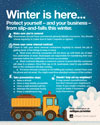Anyone who’s lived through an Ottawa winter knows it can get icy. Whether in a store’s parking lot, on the sidewalk or even in the lobby of a building, slips and falls can happen to anyone, anywhere.
The consequences can be serious – a concussion or hip fracture is not only painful, but can involve a long recovery period during which one is unable to work.
Watch Craig O’Brien talk about preventing slips and falls in a recent interview
Who’s responsible for compensating an injured person for their lost income and personal care needs? In most cases, it’s the business where the fall takes place that is liable.
While the legal risk from slips and falls is real, there’s no need for business owners to shutter their doors until the snow melts.
Craig O’Brien, a partner and civil litigation lawyer at Nelligan O’Brien Payne LLP, has some simple solutions to keep both businesses and their clients safe throughout winter.
Make sure you’re covered
Slip and fall claims can be “financially disastrous” for an uninsured business. Settlements can range anywhere from $15,000 to $2 million.
So to start, businesses should have commercial general liability insurance. This type of policy covers bodily injury and property damage stemming from visiting your place of business. You should check regularly to make sure it hasn’t expired or lapsed.
However, there’s still a significant cost to businesses that are covered by insurance in terms of time away from work. Ideally, business owners should prevent slips and falls from happening in the first place.

Know your snow removal contract
While snow removal companies are a great way to outsource the heavy lifting, O’Brien recommends that business owners or managers still engage with contractors regularly to ensure the job is getting done.
Most companies are not contracted to show up to shovel and plow until there are at least five centimetres of snow, meaning businesses remain responsible to clear their own premises if there’s less snow in the forecast.
On the flip side, many business managers are surprised to find that, following some late-winter storms, their snow removal company stops showing up altogether. Most contracts stipulate a maximum volume of snow that the contractor will clear in a season without additional payments. Once a company hits that cap, businesses need to pay those fees or the contractor will stop coming.
In the event that a snow removal company is not fulfilling its contract, O’Brien recommends that business owners contact the company both over the phone and via email. The phone call is for initial contact, to ensure the matter is corrected quickly. The written communication ensures there is time stamped evidence that you brought it to the company’s attention.

Many snow removal contracts also have an inspection clause that requires the firm to check that their client’s property is cleared even when there hasn’t been a fresh snowfall. A good snow removal company will keep careful records of these inspections and make them readily available for their clients upon request.
Take preventative steps
Even with an insurance policy and snow removal contract in place, there are steps every business should take to keep their premises safe. O’Brien recommends the following:
- Have a shovel.
- Have a mop readily accessible. People often track snow in on their boots; a mat at the doorway and a mop at the ready can help prevent accidents.
- Have a well-stocked salt bin. O’Brien points out that many winter salts are only effective to -20 degrees Celsius, so it’s important to be selective in what you buy.
- Maintain the premises hourly.
- Keep an hourly maintenance log. Logs should be kept on file for a minimum of two years to cover the statute of limitations on personal injury in Ontario.
- Complete incident reports in the event of an accident. Ideally, they should include the date and time of the incident, a statement from the patron involved and the employee who administered care, a description of the conditions, statements from any other employees who witnessed the incident and contact information for any other patrons who would be willing to act as witnesses. These, too, should be kept on file for a minimum of two years.
O’Brien also recommends that managers aim to keep contact information for former employees up-to-date, so they can call upon them to give statements even after they’ve left the company.
Lawsuits may be filed up to two years after the incident occurred. To a business owner or their staff, it may have been just another day at work. To the injured client, it was likely a life-altering and potentially traumatic experience. In instances where the accident is caught on camera, footage should be saved so it can serve as evidence down the road. Careful record keeping is key to business owners looking to guard themselves against liability in these cases.
Protective measure
While it might sound counterintuitive, O’Brien also cautions against clearing your neighbour’s snow. In the event that you clear another person’s property and create a hazard, you are actually liable should someone hurt themselves.
What can Nelligan O’Brien Payne do for you? Find a lawyer or consultant online at nelligan.ca. Craig O’Brien is a partner at the firm and a civil litigation lawyer. Reach him at craig.obrien@nelliganlaw.ca.



